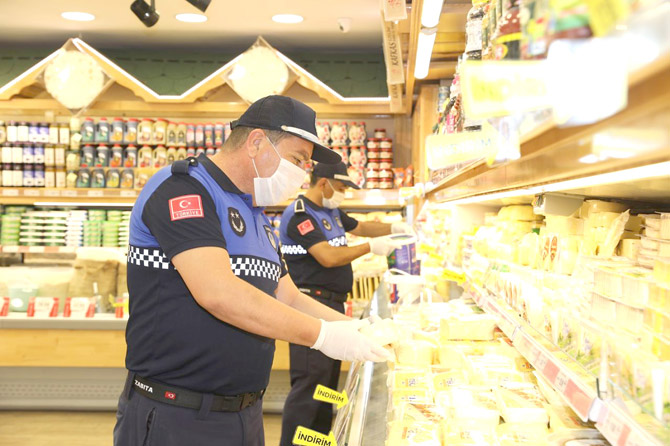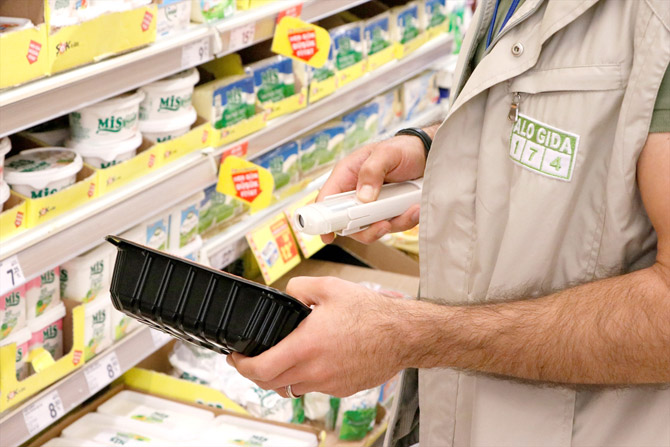The difference between producer and consumer!
The serial inspections initiated by the Ministry of Commerce after the increases in food prices triggered producers to lower prices. However, the ratio of falling prices at the producer to market shelves is still exorbitant.

The serial inspections initiated by the Ministry of Commerce after the increases in food prices triggered producers to lower prices. However, the ratio of falling prices at the producer to market shelves is still exorbitant. Consumer associations calling for the consumer to 'get into the habit of reading labels'; CIMER said that complaints can be made on Alo 174 Food Line, Alo 175 Consumer Information Line, Ministry of Commerce's Unfair Price Increase (HFA) notification application, and the warning line of the Ministry of Treasury and Finance, VIMER-189.

Increases in food prices concern all segments closely. Almost many products from milk and dairy products to fruits and vegetables, from sunflower oil to nuts, from meat to sugar were raised at a certain rate. While audits are carried out to say 'stop' to these increases, penalties are also imposed on businesses that apply exorbitant prices.

‘HIDDEN TIME IS MADE BY REDUCING WEIGHT’
However, "hidden hikes" have begun to be made on some products recently. While this is the case especially for snack products such as chocolate, cakes and crackers, as well as cheddar cheeses, various dried fruit brands apply the same method. Calling the consumer to 'get the habit of reading labels', consumer associations emphasize that they cannot be deceived in perception and that companies will no longer dare to do so when they report all the crimes they notice.
‘COMPLAIN TO THE MINISTRY OF COMMERCE’
The following suggestions are offered to consumers from associations: It is especially recommended to 'read labels' in order to prevent consumers from falling into these errors. Errors seen and noticed tricks can be photographed. The consumer cannot weigh every product, but can weigh the product he suspects and complain to the relevant institutions. The photos taken should be sent to the Consumer Arbitration Committees. In determining the nonconformities in question; Inspections are also carried out as a result of the notification, complaint, CIMER and Alo 174 Food Line applications made by the consumers. These inspections are carried out by affiliated unions of the Ministry of Agriculture and Forestry. In addition, the Ministry of Commerce's Unfair Price Increase (HFA) notification application, Alo 175 Consumer Information Line, and the notification line of the Ministry of Treasury and Finance, VIMER-189 can also be used.
‘THERE IS A DIFFERENCE BETWEEN THE MANUFACTURER AND THE CONSUMER’
In January, pasteurized milk became the champion with 23.65 percent. The product that fell the most in price was cauliflower with 34.59 percent. Turkey Union of Chambers of Agriculture chairman Shams Bayraktar, announced the changes brought in food prices in January, stores and manufacturers. Bayraktar said that the cabbage, which was 68 cents at the producer, was sold for 2 lira 70 kuruş, parsley which was 50 kurus for 1 lira 96 kurus, and 2 lira 73 kuruş milk for 8 lira 94 kuruş. TZOB President Bayraktar said that in this period, producer and market prices should be closely monitored so that citizens can consume products at reasonable prices.
‘THEY BUY THE EGG FOR 16 TL AND SELL IT ALMOST DOUBLE’
Emphasizing that the exit price of eggs from the producer is of great importance, Konya Egg Producers Union (YUMBİR) President İsmail Saraçoğlu said, “The exit price of eggs from the producer for 1 month is the highest 16 lira. They did not drop below 24 liras in the markets. Our entries have increased so much, we do not know how it will be, but we struggle every day on this issue. The exchange rate first triggered the rise in egg prices. Later, the exchange rate started to decrease, but the countries that produce protein sources do not want to sell products such as soy and sunflower. If we do not import them, our chances of producing feed are low. Egypt had almost no soy production but produced in Turkey. The import prices of these products increased significantly. Soybean increased from $ 340 to $ 620. All of these trigger egg production from the forage leg. As the production cost increases, the poultry is in a difficult situation. Market prices do not affect us much. Exit prices from the producer are important, but the prices of the eggs at the producer must be at least 18 lira. "It is the markets that make the real money."
‘MORE THAN 1 MILLION ANIMALS WILL BE CUT’
Producers attribute the increase in egg prices to higher feed costs. Saraçoğlu said, “Last week, around 300 thousand animals were slaughtered in Konya. By March, over 1 million animals should be slaughtered. Because the producer does not have the power to supply and grow new animals. "As the raw material prices increased, the producer suffered a loss."
‘MANUFACTURER AND CONSUMER ARE HAZARDOUS’
Stating that they are experiencing a shortage of raw materials, Saraçoğlu said: “It is the producer and consumer who suffer from egg prices. No problem with the middlemen, they always make money. Last week, around 300 thousand animals were slaughtered in Konya. By March, over 1 million animals should be slaughtered because the producer does not have the power to supply and raise new animals. When raw material prices increased, the producer suffered losses. Until the chick is 160 days old, an animal costs 32-33 thousand liras. When we raise 100 thousand animals, it requires 3 million 200 thousand liras. It is also currently not available in any of my manufacturers. People have started to flee from the industry now. We had an Iraqi market. I think they will be seriously producers in a year. There, 360 eggs are sold for $ 54. Turkey exported eggs while putting price of $ 25-26. Speaking of shipping costs, it goes there for 43-44 dollars. They sell imported products for $ 46, but their domestic production costs $ 54. It also saves the producer there. But because we sell goods for $ 26, we are losing money. "

‘THE MANUFACTURERS ALSO LEFT IN THE OPPORTUNITIES’
Stating that there was an increase in egg consumption due to curfews on the weekend, Saraçoğlu said, “There is no problem in consumption, the problem will be in the production side. Some of the eggs that I sold for 500 liras were also sold for one thousand 100 liras. It is necessary to identify those who do them and prevent them. People need to know the true nutritional value of eggs. For example, some choose the egg I produce, decorate it, sell one egg for the money of three eggs. That is, it is necessary to inform these people in this direction. People think that eggs with high prices are good and buy them. Actually, all eggs are good. There is no such thing as a bad egg. But there are producers who cannot explain what they say, ”he concluded his words.
SÜMEYRA KENESARI / YENİ HABER GAZETESİ
